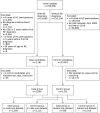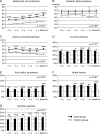Sex differences in risk factors for future onset of reflux esophagitis
- PMID: 34376918
- PMCID: PMC8325768
- DOI: 10.3164/jcbn.20-202
Sex differences in risk factors for future onset of reflux esophagitis
Abstract
Reflux esophagitis is known to be more prevalent in males, and previous studies have suggested sex differences in its risk factors. However, little is known about sex differences in the time-course of risk factors before reflux esophagitis onset. Thus, we conducted a retrospective longitudinal study using health checkup records. From the records of 230,056 individuals obtained from nine institutes in Japan, we selected 1,558 male reflux esophagitis cases, 3,116 male controls, 508 female reflux esophagitis cases, and 1,016 female controls were selected. We compared time-courses of risk factors between the case and control groups and identified abdominal circumference (AC), diastolic blood pressure, alanine transaminase (ALT), and current smoking in males and body mass index (BMI) in females as sex-specific risk factors. We also found that AC and ALT in males and BMI in females were significantly different between the reflux esophagitis case and control groups during the five years before reflux esophagitis onset. Our results suggest that visceral fat-type obesity and fatty liver in males and higher BMI in females are more frequently observed in reflux esophagitis cases several years before reflux esophagitis onset, and that proactive intervention to lifestyle can help prevent reflux esophagitis in both males and females.
Keywords: longitudinal study; real world evidence; reflux esophagitis; risk factors; sex differences.
Copyright © 2021 JCBN.
Conflict of interest statement
No potential conflicts of interest were disclosed.
Figures



Similar articles
-
Predictive Factors for Future Onset of Reflux Esophagitis: A Longitudinal Case-control Study Using Health Checkup Records.J Neurogastroenterol Motil. 2022 Jan 30;28(1):86-94. doi: 10.5056/jnm20237. J Neurogastroenterol Motil. 2022. PMID: 34980691 Free PMC article.
-
Association of Visceral Fat Area, Smoking, and Alcohol Consumption with Reflux Esophagitis and Barrett's Esophagus in Japan.PLoS One. 2015 Jul 30;10(7):e0133865. doi: 10.1371/journal.pone.0133865. eCollection 2015. PLoS One. 2015. PMID: 26225858 Free PMC article.
-
Visceral fat obesity is the key risk factor for the development of reflux erosive esophagitis in 40-69-years subjects.Esophagus. 2021 Oct;18(4):889-899. doi: 10.1007/s10388-021-00859-5. Epub 2021 Jun 12. Esophagus. 2021. PMID: 34117973 Free PMC article.
-
Abdominal obesity increases the risk of reflux esophagitis: a systematic review and meta-analysis.Scand J Gastroenterol. 2022 Feb;57(2):131-142. doi: 10.1080/00365521.2021.1994643. Epub 2021 Nov 5. Scand J Gastroenterol. 2022. PMID: 34738858
-
Offspring body size and metabolic profile - effects of lifestyle intervention in obese pregnant women.Dan Med J. 2014 Jul;61(7):B4893. Dan Med J. 2014. PMID: 25123127 Review.
References
-
- Hongo M, Shoji T. Epidemiology of reflux disease and CLE in East Asia. J Gastroenterol 2003; 38 Suppl 15: 25–30. - PubMed
-
- Yasuhara H, Miyake Y, Toyokawa T, et al. Large waist circumference is a risk factor for reflux esophagitis in Japanese males. Digestion 2010; 81: 181–187. - PubMed
-
- Sogabe M, Okahisa T, Kimura Y, Hibino S, Yamanoi A. Visceral fat predominance is associated with erosive esophagitis in Japanese men with metabolic syndrome. Eur J Gastroenterol Hepatol 2012; 24: 910–916. - PubMed
-
- Moki F, Kusano M, Mizuide M, et al. Association between reflux oesophagitis and features of the metabolic syndrome in Japan. Aliment Pharmacol Ther 2007; 26: 1069–1075. - PubMed

